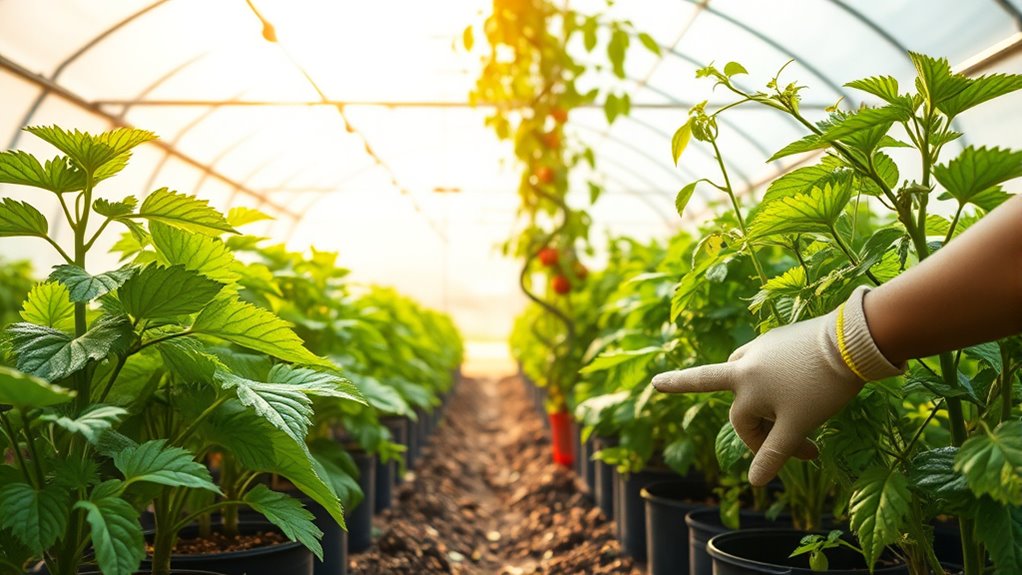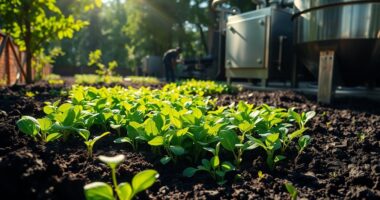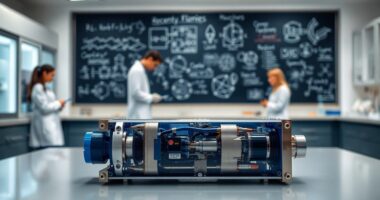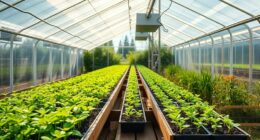By setting up a greenhouse with hydroponic systems, you can grow fresh produce year-round right at home, dramatically cutting your food miles and carbon footprint. This controlled environment allows you to extend growing seasons, reduce reliance on imported food, and minimize transportation emissions. Plus, less pest damage and water waste make your gardening more eco-friendly. Keep exploring to discover how integrating these sustainable methods can make a big impact on your eco lifestyle.
Key Takeaways
- Greenhouse gardening allows year-round cultivation close to home, reducing the need for long-distance food transportation.
- Growing fresh produce locally decreases food miles, lowering associated carbon emissions and environmental impact.
- Hydroponic systems in greenhouses boost yields and efficiency, maximizing local food production with minimal resource use.
- Controlled environments prevent pests and diseases naturally, reducing reliance on chemical pesticides and further lowering environmental footprint.
- Extending growing seasons through greenhouses ensures access to fresh food year-round, decreasing dependence on store-bought, transported produce.

Greenhouse gardening offers you a controlled environment to grow plants year-round, regardless of outside weather conditions. This setup allows you to produce fresh, healthy food closer to home, notably reducing your food miles and your overall carbon footprint. One of the key advantages is that you can optimize growing conditions, making your garden more efficient and sustainable. By integrating hydroponic systems into your greenhouse, you can grow a variety of crops without soil, which often results in faster growth and higher yields. These systems use nutrient-rich water solutions, reducing water waste and making it easier to manage plant health compared to traditional soil gardening.
Greenhouse gardening enables year-round, efficient crop production with hydroponics, reducing waste and boosting sustainability.
Using hydroponic systems also simplifies pest management. Since there’s no soil involved, many soil-borne pests and diseases are eliminated or markedly reduced. This means you’re less likely to rely on chemical pesticides, making your produce safer and more eco-friendly. Instead, you can focus on integrated pest management techniques, such as introducing beneficial insects or using organic deterrents. The controlled environment of a greenhouse further aids pest management by allowing you to monitor and respond quickly to any issues, preventing infestations from spreading and reducing the need for harmful chemicals.
Furthermore, greenhouse gardening gives you the flexibility to grow crops that might not thrive outdoors due to climate limitations. You can extend your growing season, cultivating fresh vegetables and herbs well beyond traditional harvest times. This not only cuts down on your reliance on store-bought produce, which often travels long distances, but also ensures you have access to fresh, nutritious food whenever you want it. The result is a noteworthy reduction in the carbon emissions associated with food transportation.
In addition, managing pests effectively in a greenhouse setting means you can minimize waste caused by pest damage. Healthy plants produce more food, which means less waste and a smaller environmental impact. With proper pest management strategies, you also lower the need for chemical interventions, aligning your gardening practices with sustainable principles. Incorporating advanced technology such as climate control systems can further optimize your greenhouse environment, leading to even greater efficiency and sustainability.
Frequently Asked Questions
How Does Greenhouse Gardening Compare to Traditional Farming in Water Usage?
Greenhouse gardening typically uses less water than traditional farming because it allows for better water conservation and more efficient irrigation techniques. You can control water supply more precisely, reducing waste and promoting sustainable practices. Unlike open-field farming, greenhouses minimize evaporation and runoff, helping you conserve water while growing healthy plants. This method makes it easier for you to adopt eco-friendly practices that support environmental sustainability and conserve essential water resources.
What Are the Initial Costs of Setting up a Greenhouse for Food Production?
When you consider greenhouse costs, the initial setup involves several startup expenses. You’ll need to invest in quality framing, climate control systems, and lighting, which can vary widely depending on size and complexity. Expect to spend on insulation, ventilation, and possibly automation. While these startup expenses might seem high at first, they pay off through increased crop yields and year-round growing, making greenhouse gardening a smart, sustainable choice for food production.
Can Greenhouse Gardening Be Practiced Year-Round in All Climates?
Did you know that greenhouse gardening can often be practiced year-round in many regions? While seasonal limitations exist, climate adaptability plays a big role. With the right insulation, heating, and cooling systems, you can extend growing seasons and grow fresh produce throughout the year. However, in extreme climates, additional modifications may be necessary. So, yes, with proper setup, you can enjoy year-round gardening regardless of your location.
What Are the Best Crops for Beginner Greenhouse Gardeners?
For beginner greenhouse gardeners, easy crop choices include lettuce, radishes, herbs, and tomatoes. These plants grow quickly and require minimal soil preparation, making them perfect for newbies. You should focus on soil preparation tips like using quality potting mix, ensuring proper drainage, and maintaining consistent moisture. Starting with these crops helps you build confidence, learn greenhouse care, and enjoy fresh produce year-round, regardless of your climate.
How Do Greenhouse Conditions Affect Pest and Disease Management?
Did you know that greenhouse conditions can reduce pest infestations by up to 50%? You can better manage pests and diseases by adjusting humidity, temperature, and ventilation. These factors influence pest control strategies and disease prevention methods, making it easier to maintain healthy plants. By controlling environmental conditions, you create a less inviting habitat for pests and pathogens, so you spend less time on chemical treatments and more on enjoying your garden.
Conclusion
By embracing greenhouse gardening, you’re planting seeds for a greener future right in your own backyard. It’s like turning your home into a fortress against climate change, shrinking your food miles and your carbon footprint. Every fresh vegetable you harvest is a victory for the planet, proving that even small actions can make a big difference. So, get your hands dirty and watch your eco-impact bloom—because together, we can cultivate change.








